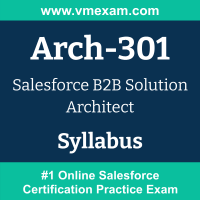 The Salesforce Arch-301 exam preparation guide is designed to provide candidates with necessary information about the B2B Solution Architect exam. It includes exam summary, sample questions, practice test, objectives and ways to interpret the exam objectives to enable candidates to assess the types of questions-answers that may be asked during the Salesforce Certified B2B Solution Architect exam.
The Salesforce Arch-301 exam preparation guide is designed to provide candidates with necessary information about the B2B Solution Architect exam. It includes exam summary, sample questions, practice test, objectives and ways to interpret the exam objectives to enable candidates to assess the types of questions-answers that may be asked during the Salesforce Certified B2B Solution Architect exam.
It is recommended for all the candidates to refer the Arch-301 objectives and sample questions provided in this preparation guide. The Salesforce B2B Solution Architect certification is mainly targeted to the candidates who want to build their career in Salesforce Architect domain and demonstrate their expertise. We suggest you to use practice exam listed in this cert guide to get used to with exam environment and identify the knowledge areas where you need more work prior to taking the actual Salesforce B2B Solution Architect exam.
Salesforce Arch-301 Exam Summary:
|
Exam Name
|
Salesforce B2B Solution Architect |
| Exam Code | Arch-301 |
| Exam Price |
Registration fee: USD 400 Retake fee: USD 200 |
| Duration | 120 minutes |
| Number of Questions | 65 |
| Passing Score | 58% |
| Recommended Training / Books |
Prepare for the Salesforce B2B Solution Architect Credential Study for the B2B Solution Architect Certification |
| Schedule Exam |
Kryterion Webassessor PEARSON VUE |
| Sample Questions | Salesforce Arch-301 Sample Questions |
| Recommended Practice | Salesforce Certified B2B Solution Architect Practice Test |
Salesforce B2B Solution Architect Syllabus:
| Section | Objectives | Weight |
|---|---|---|
| Discovery and Customer Success |
- Given a scenario in which a customer wants a B2B multi-cloud solution, document and articulate the business needs, value, and vision of the customer to support their desired business outcomes. - Given the identified business needs, vision, and current customer landscape, define the future blueprint architecture of a B2B multi-cloud Salesforce solution in order to define the product roadmap. - Given that a future blueprint architecture has been agreed upon, define the incremental steps necessary to reach the recommended future end state that supports business outcomes. |
25% |
| Data Governance and Integration |
- Given a complex data architecture, define the data flows across systems, the methods and techniques to connect systems, and the relationship each system has to the data it contains. - Given the current architecture, define the strategy to migrate data, and synchronize data across systems to support a multi-cloud B2B solution. - Given existing customer personas and the defined business requirements, design and map a sharing and visibility model for a B2B multi-cloud Salesforce solution. - Given customer expectations around data volumes, provide governance to satisfy business requirements. |
26% |
| Design |
- Given information gathered during discovery, define the functional and technical solution, in line with Salesforce standards, keeping the business value and objectives in mind. - Given a set of business requirements, recommend an appropriate Salesforce multi-cloud or AppExchange solution. - Given a scenario, identify design options and their associated risks, assess their level of criticality, and recommend the solution that most accurately meets the specified functional and nonfunctional requirements. - Given a scenario in which the design document is being shared, facilitate final acceptance from stakeholders by ensuring any concerns raised are adequately addressed. - Given a defined future state B2B multi-cloud solution architecture alongside business requirements, choose the preferred method for integrating data across different clouds. |
29% |
| Delivery |
- When planning a B2B multi-cloud set of orgs and environments, define appropriate strategies that balance resources and effort to deliver an effective and efficient delivery method. - When planning the steps involved in delivering a customer's business outcomes, ensure that there is a clear understanding of business requirements through to the delivered configuration. - Given a scenario in which the designed solution is being implemented, provide the appropriate display of the capabilities of that solution to stakeholders (demos) that demonstrate continued alignment with the desired business outcomes and priorities. |
12% |
| Operationalize the Solution |
- Given that a solution has been implemented, ensure that stakeholders are appropriately enabled to manage the solution moving forward (for example, updating documentation, center of excellence, training). - Given a scenario in which a B2B multi-cloud solution has been implemented, determine how to further improve the solution to ensure business benefits are continuously realized. - Determine how to facilitate adoption in order for the business to benefit from a B2B multi-cloud solution. |
8% |
